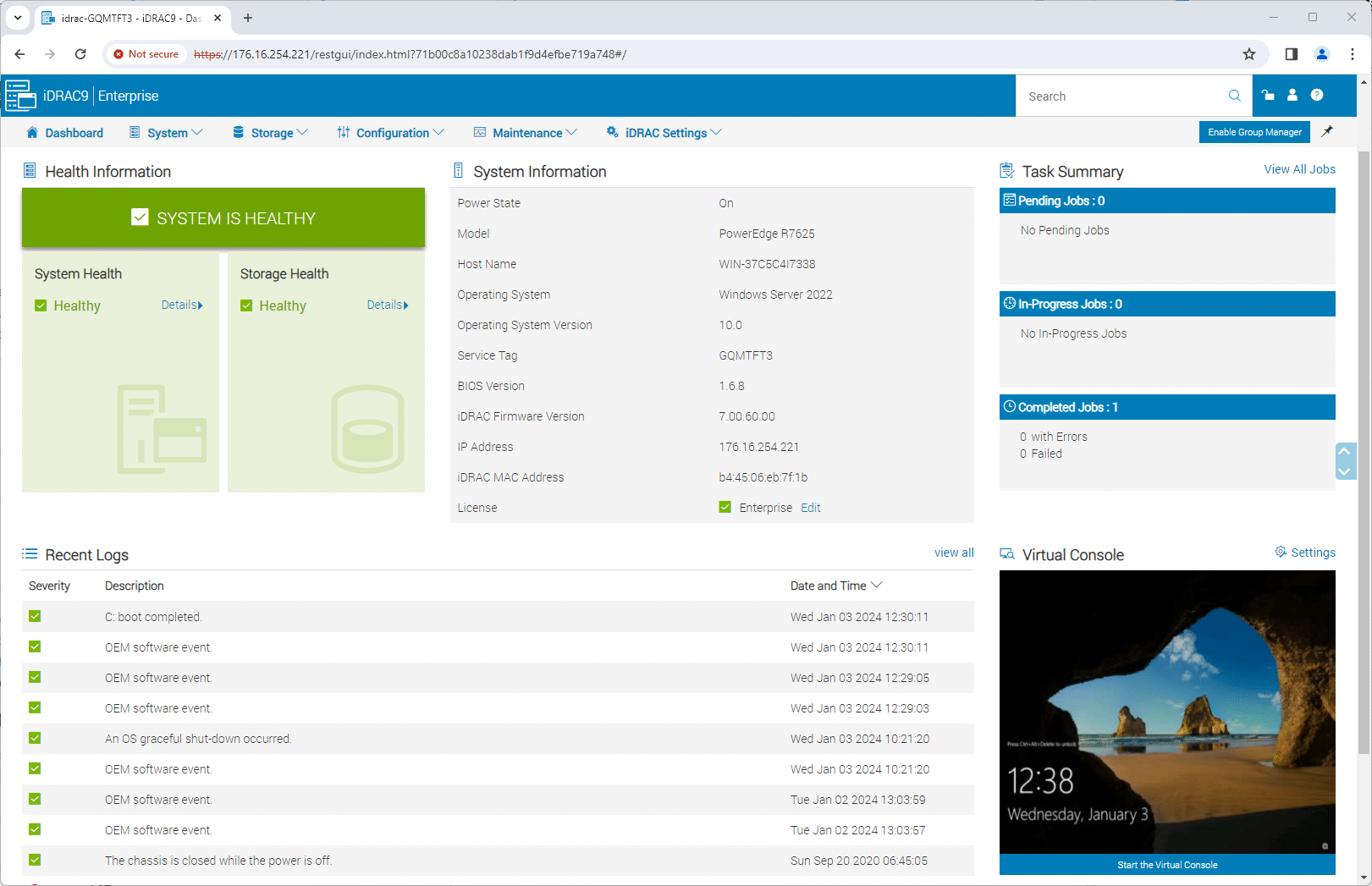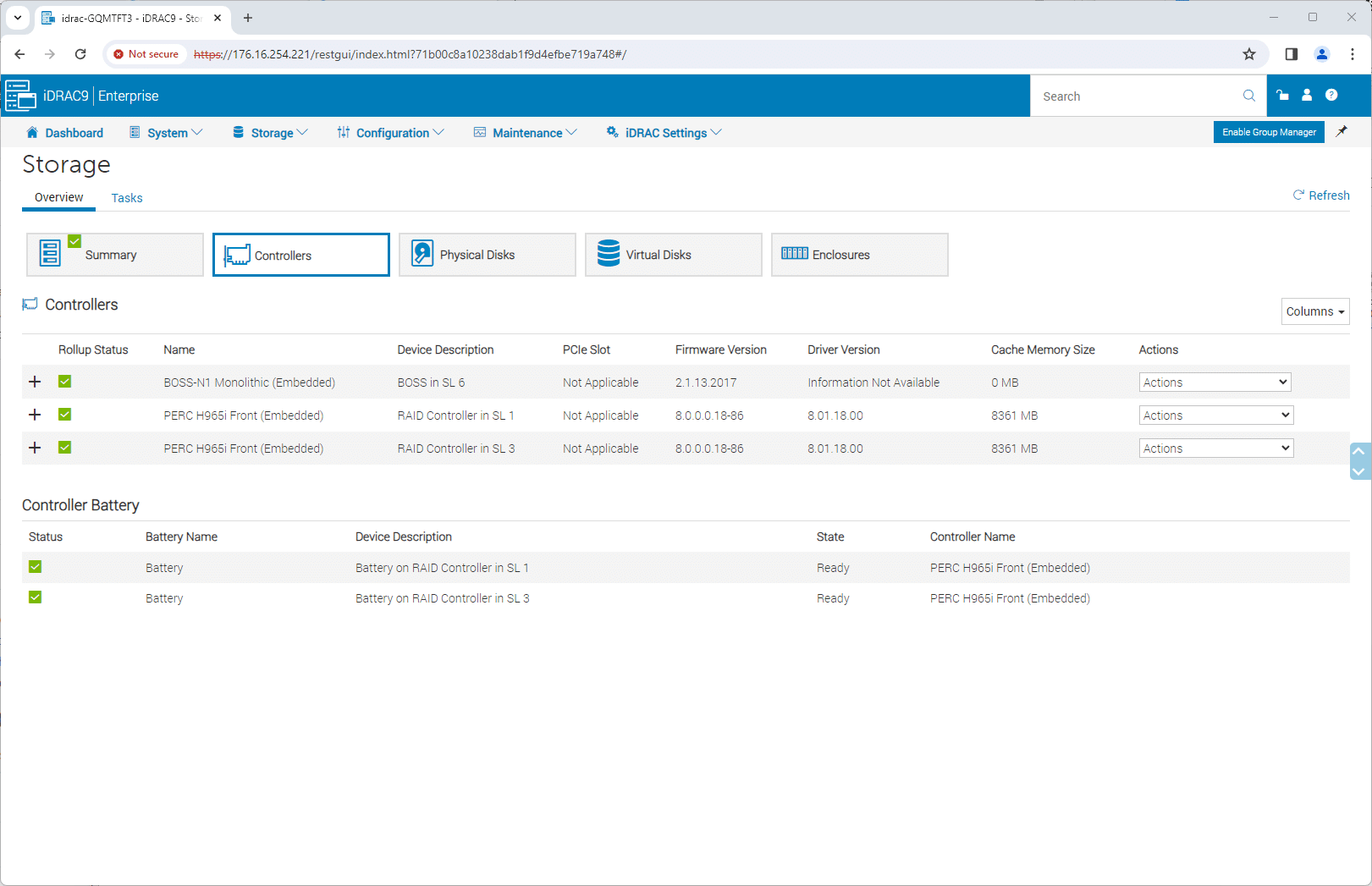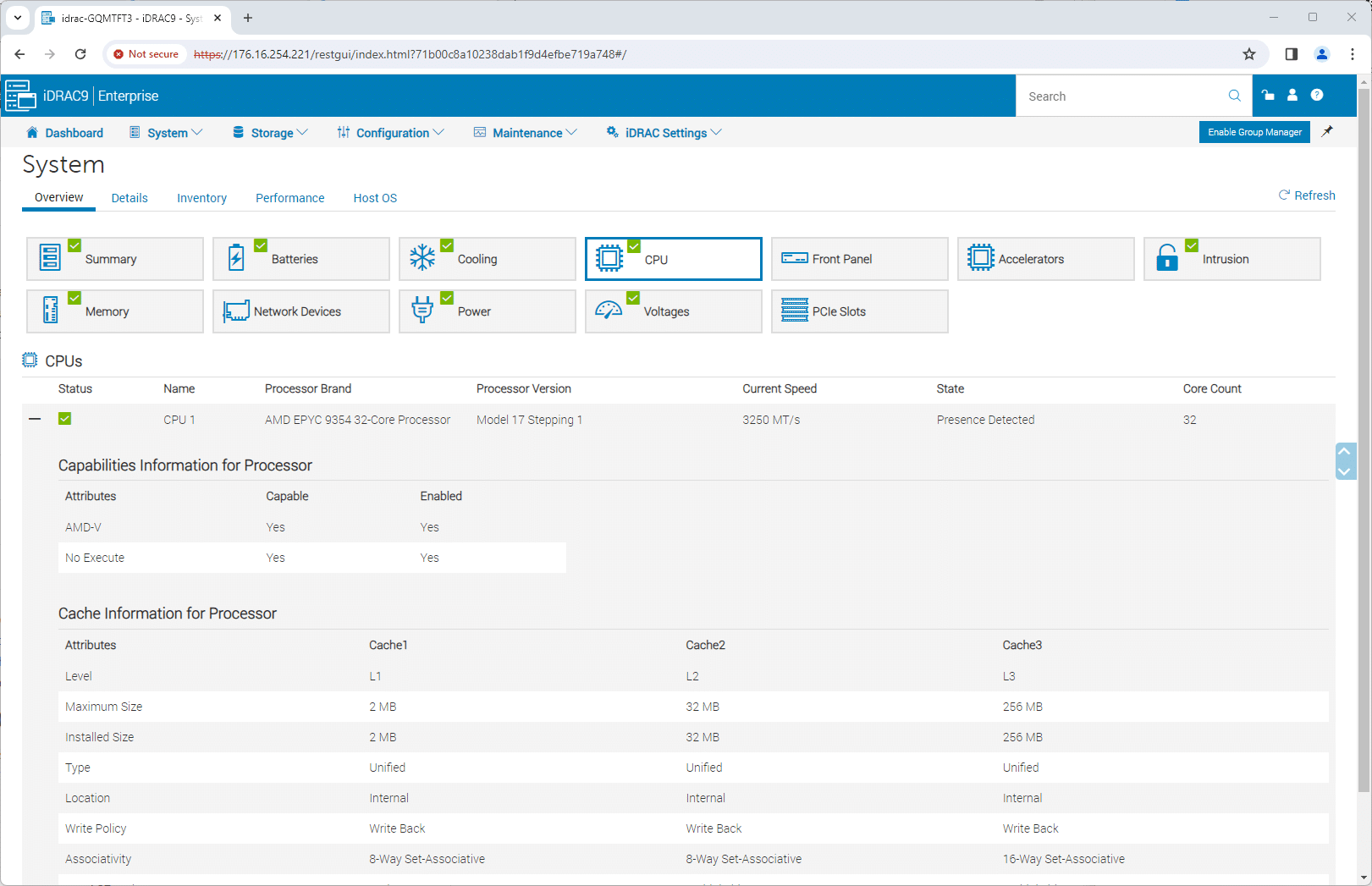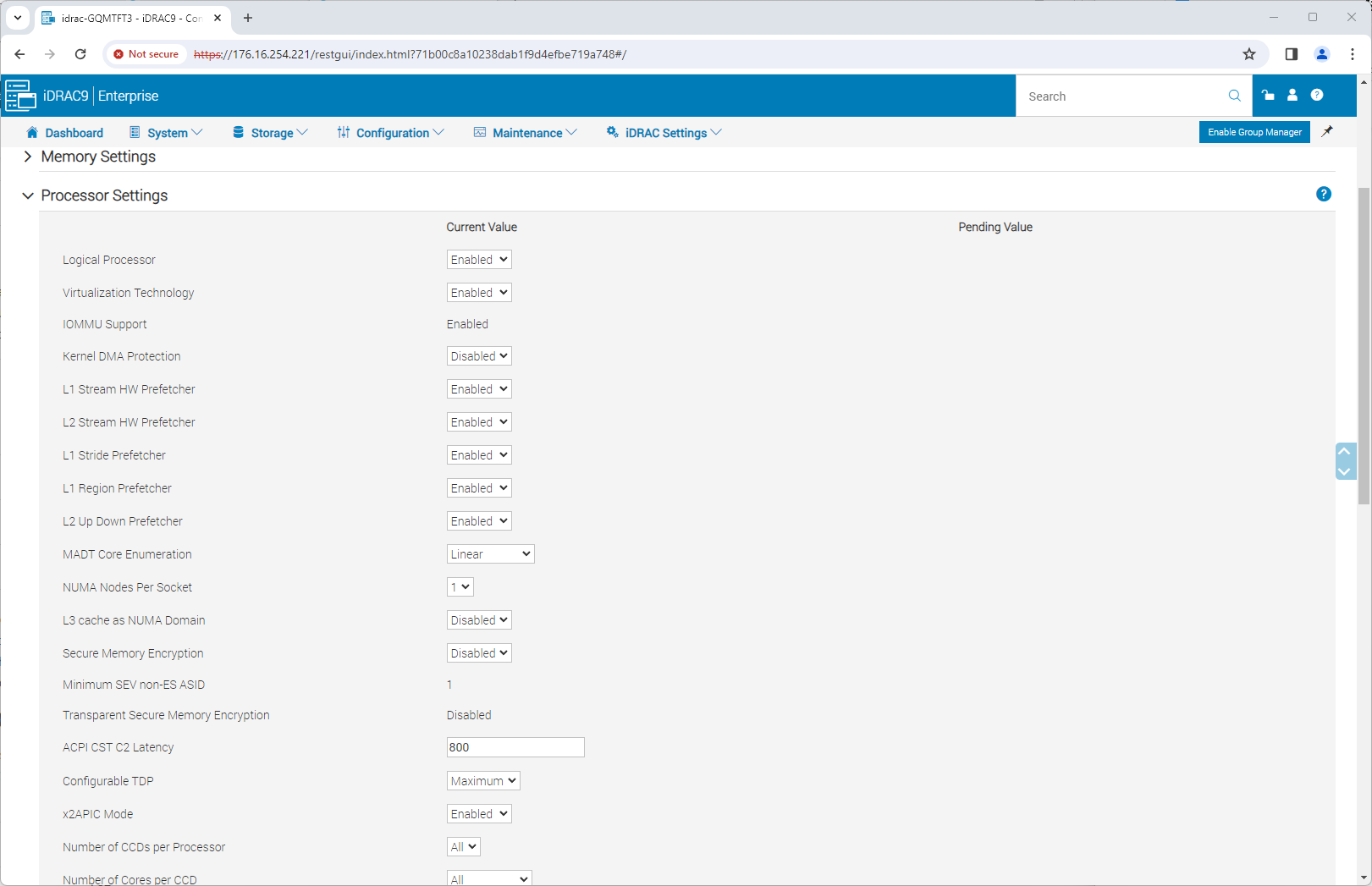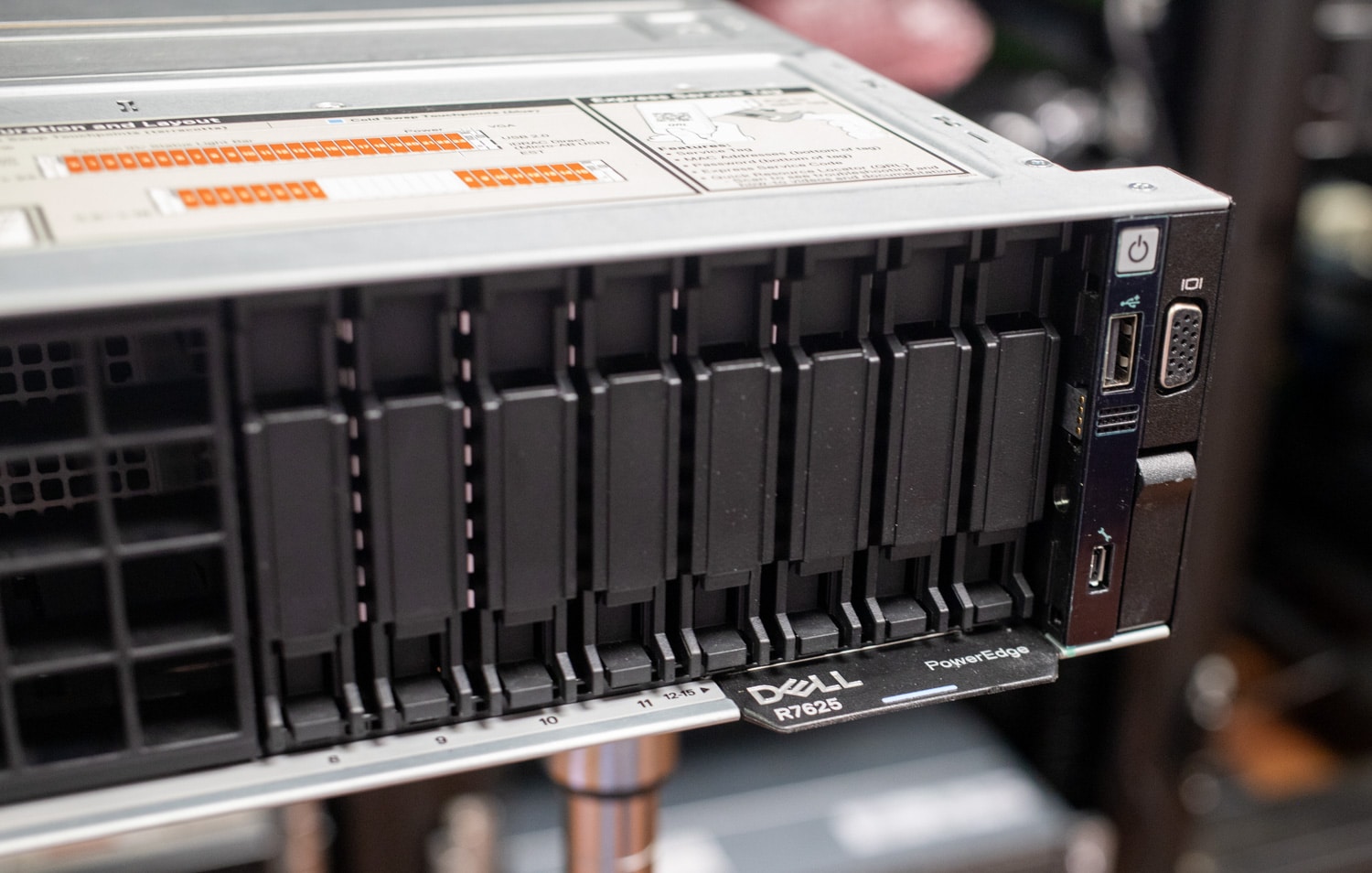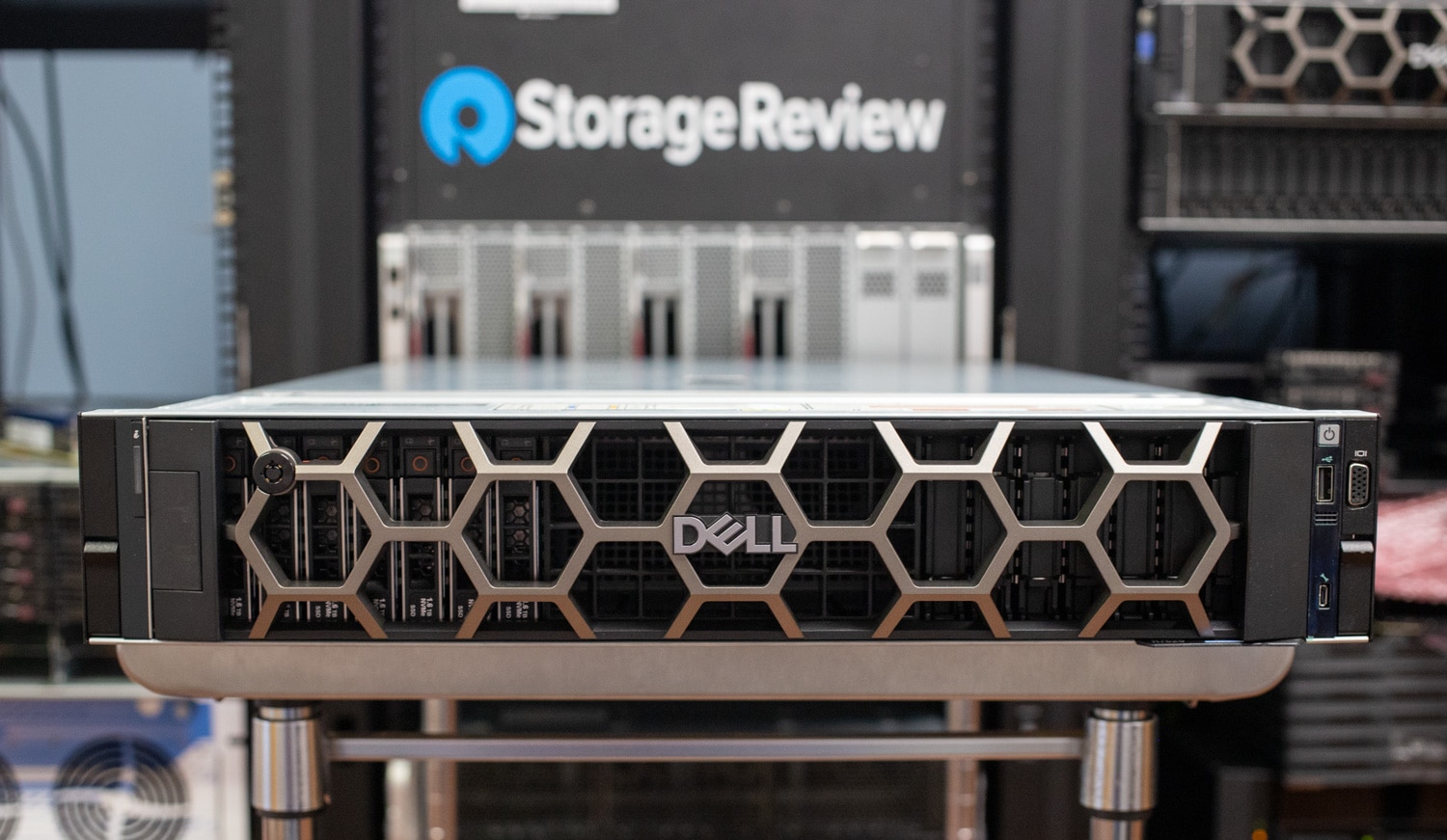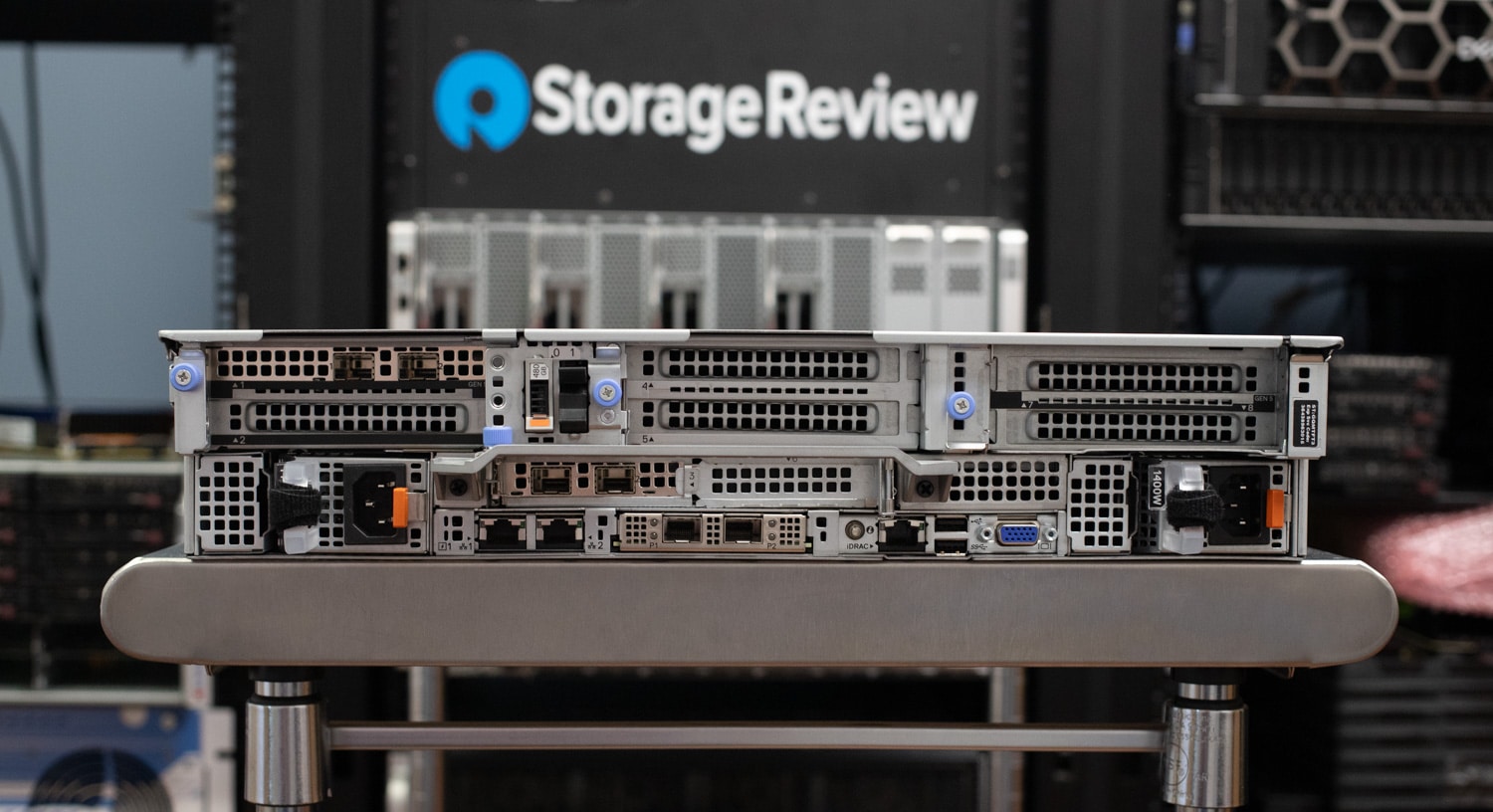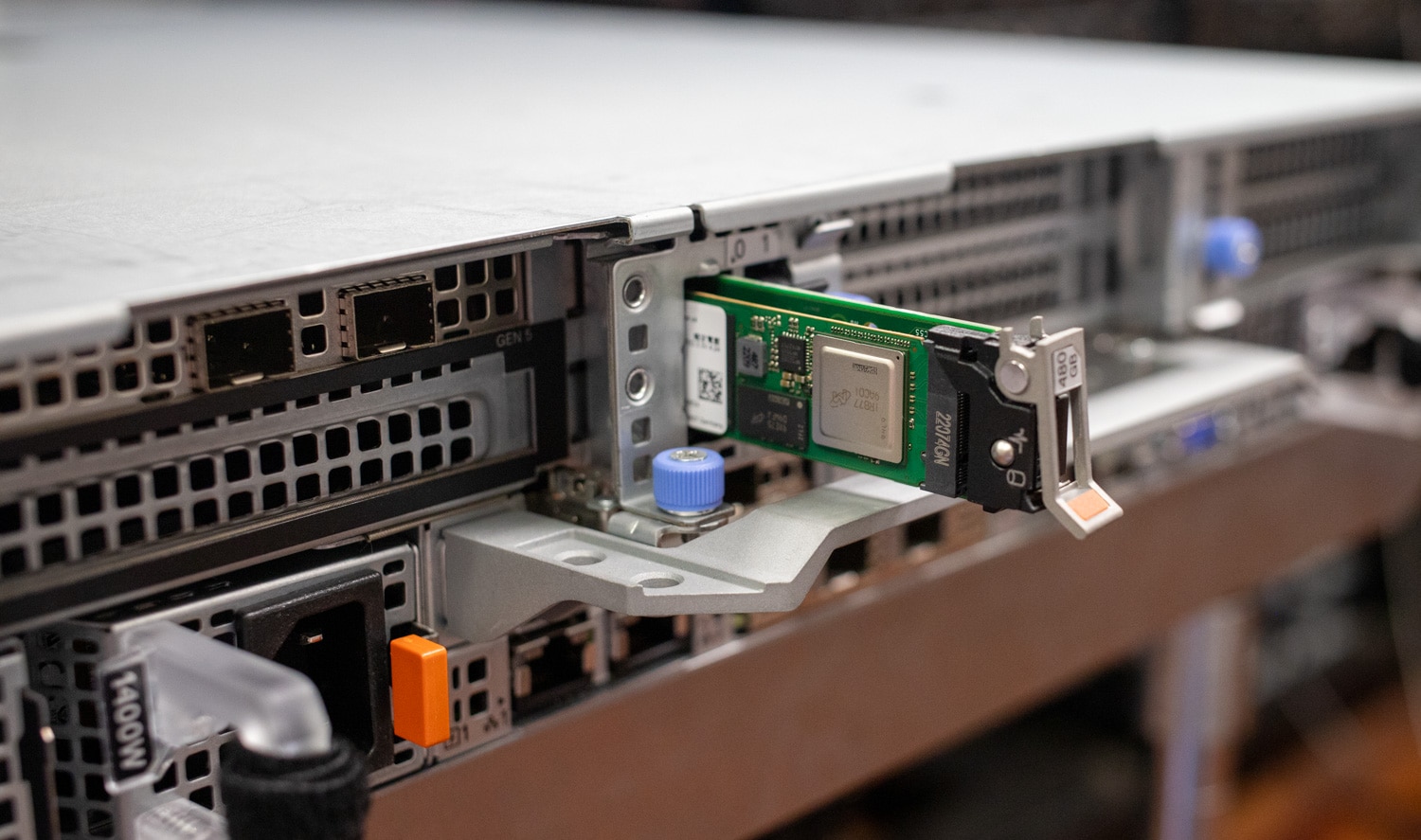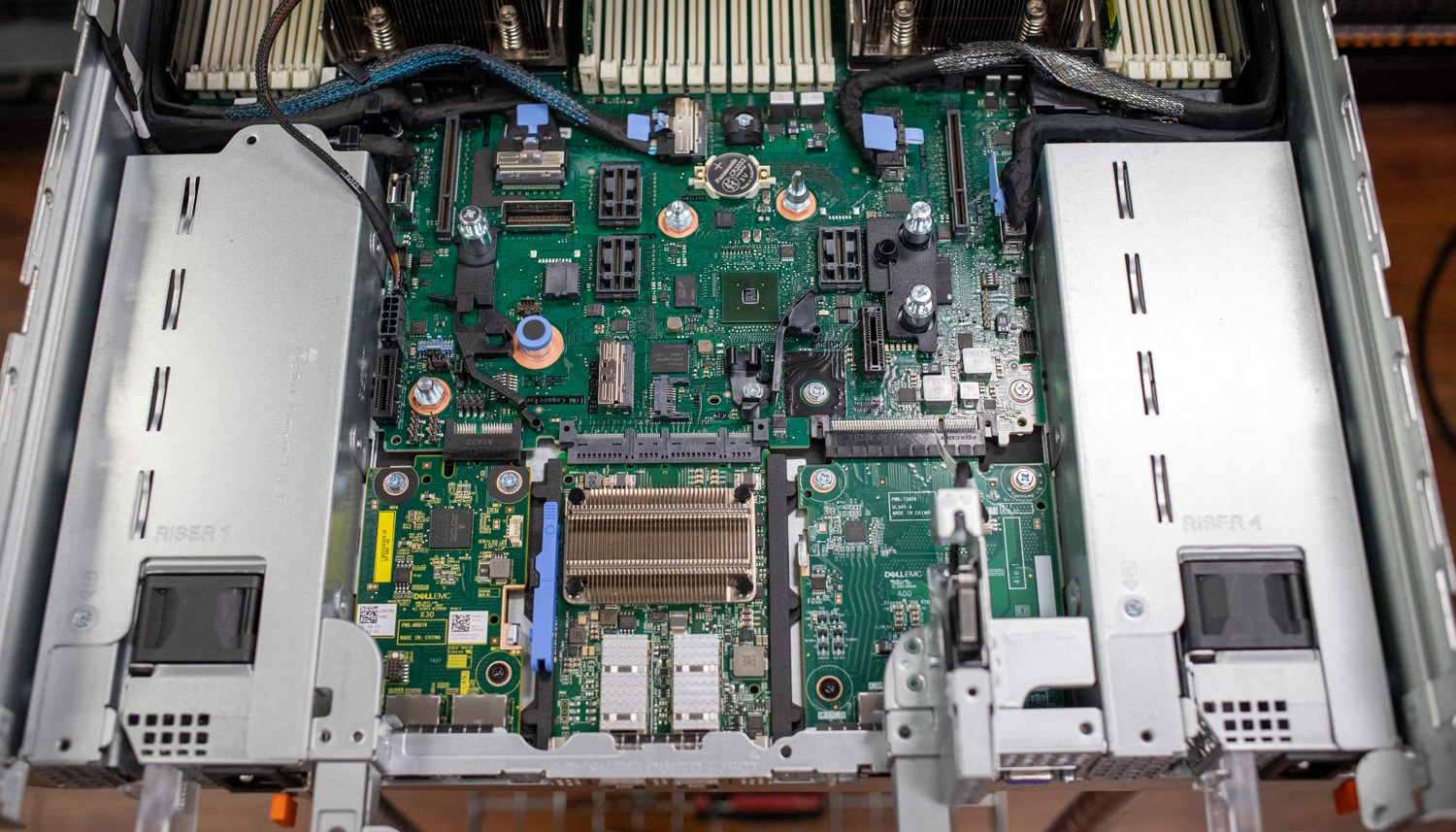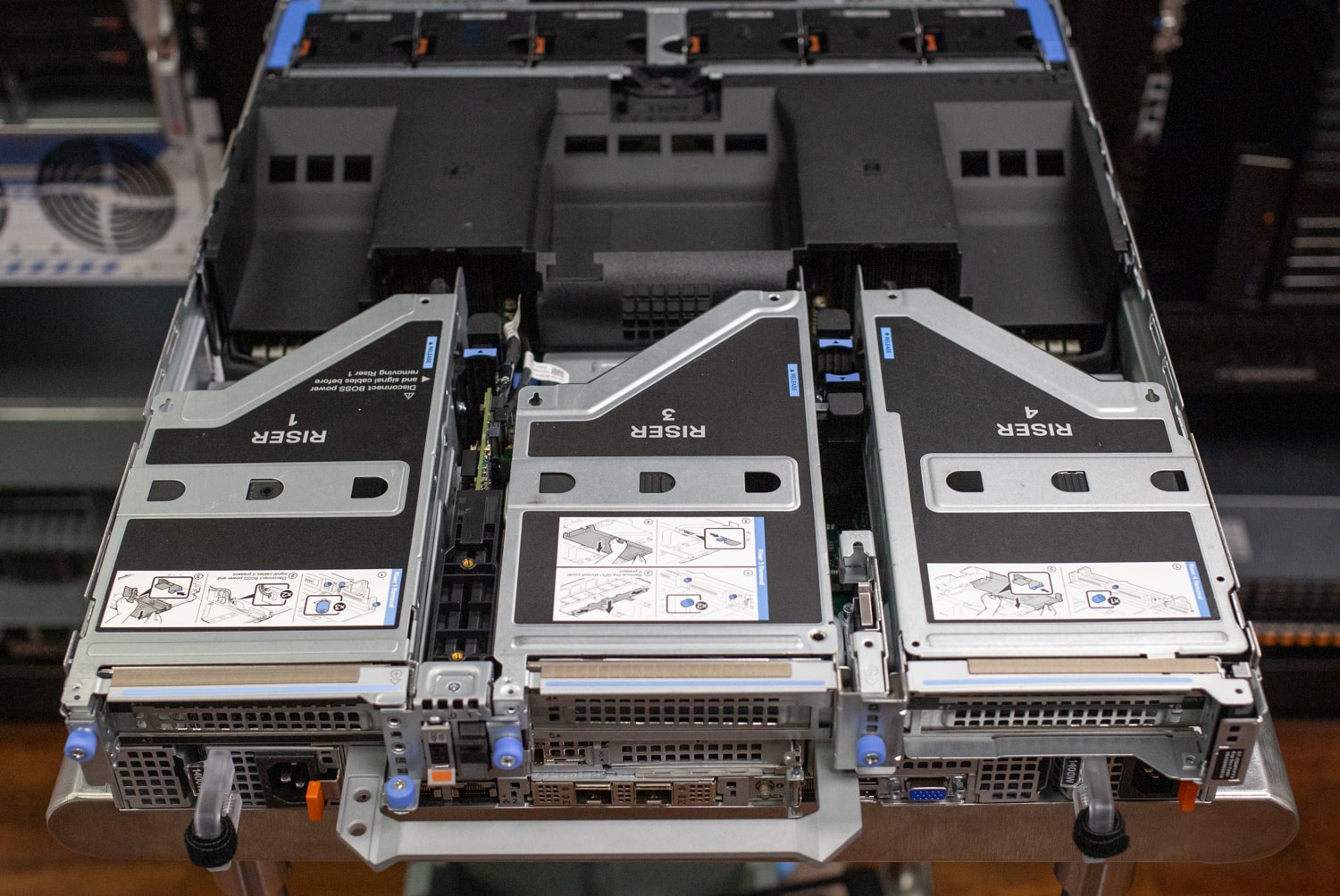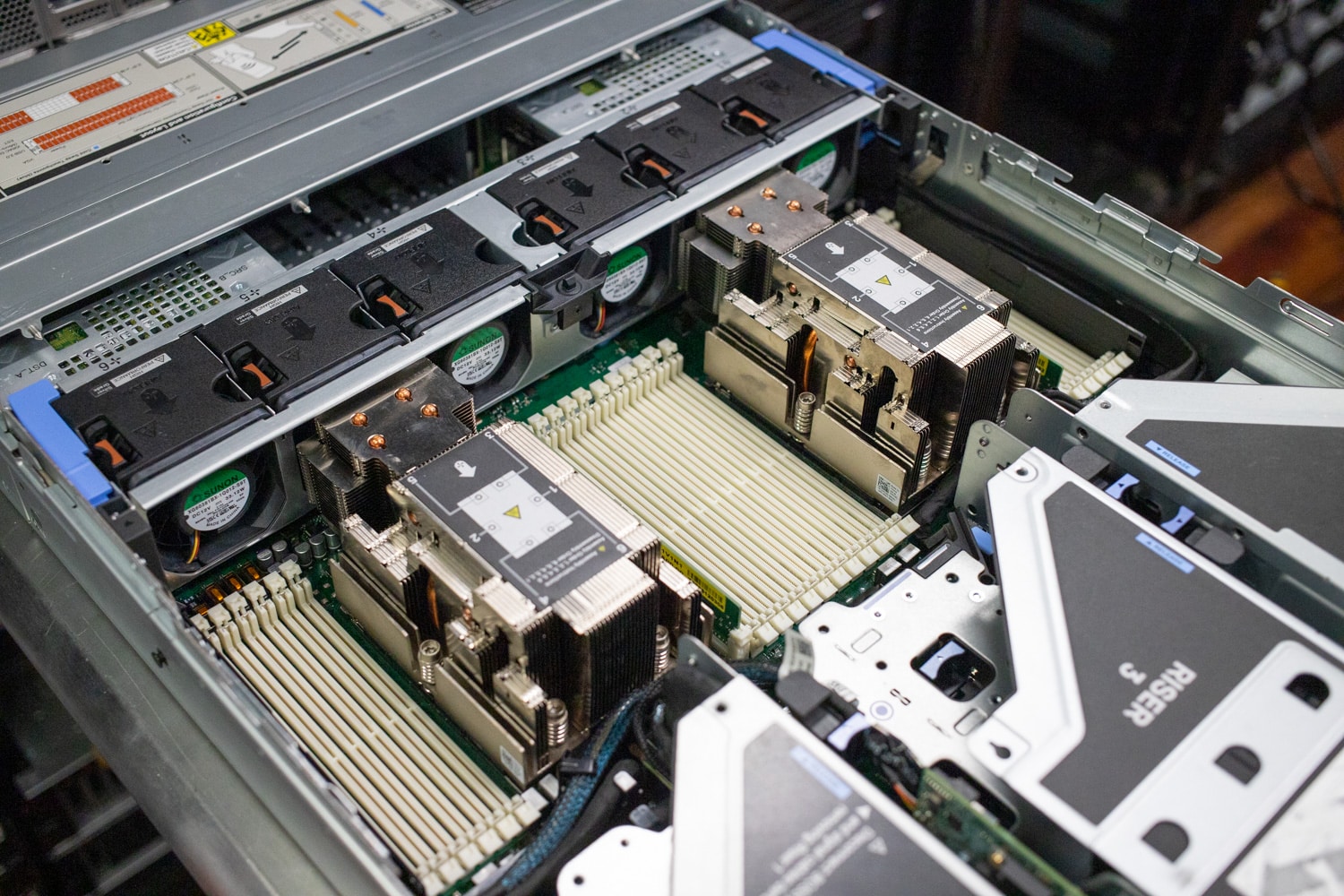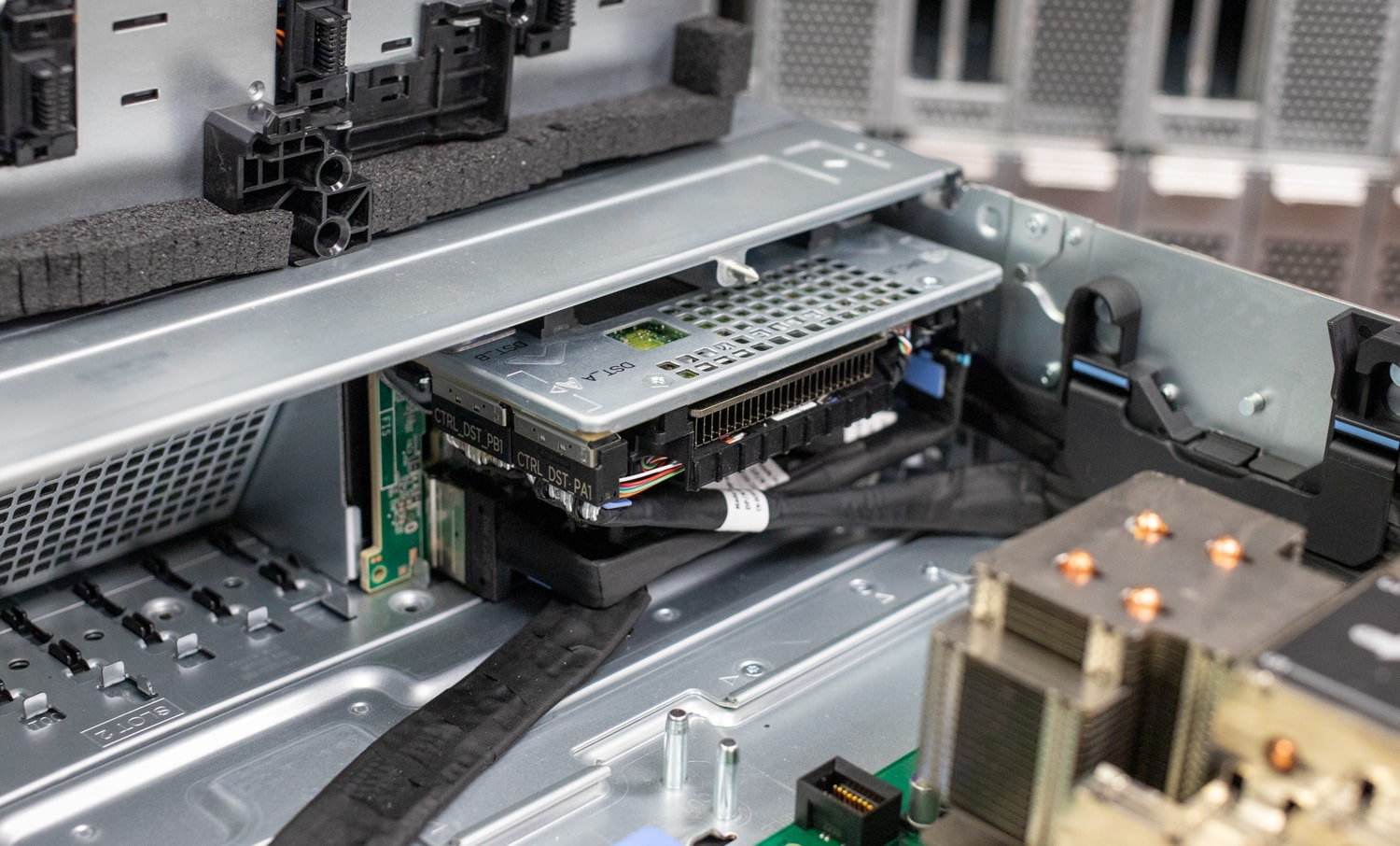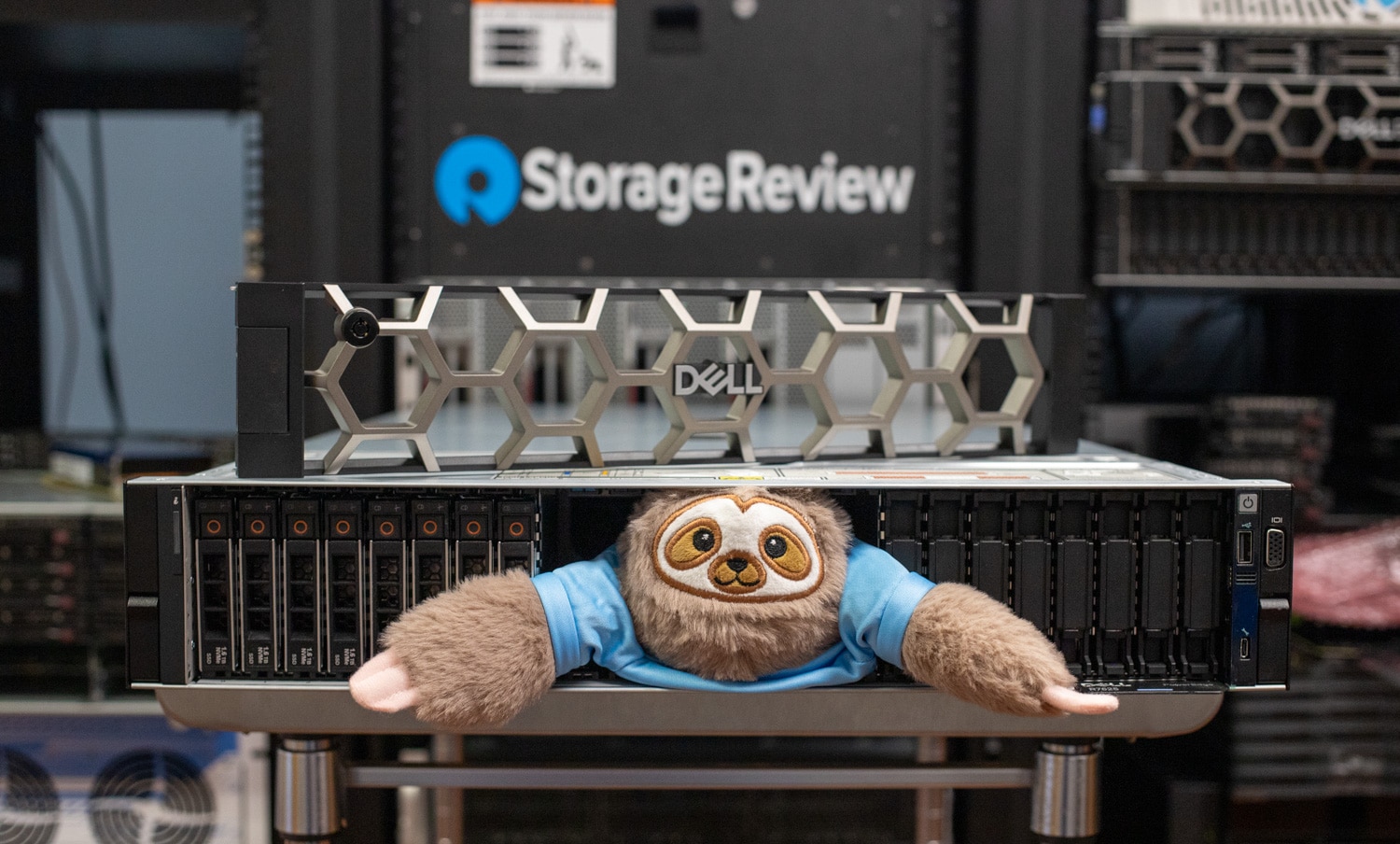The Dell PowerEdge R7625 2U server takes the potential of the R7615 much further by adding a second CPU and doubling memory support to 6TB.
The dual-CPU Dell PowerEdge R7625 2U rack server is ideal for HPC, VDI, and virtualization workloads, thanks to its massive core count, high memory ceiling, and PCIe Gen5 support.
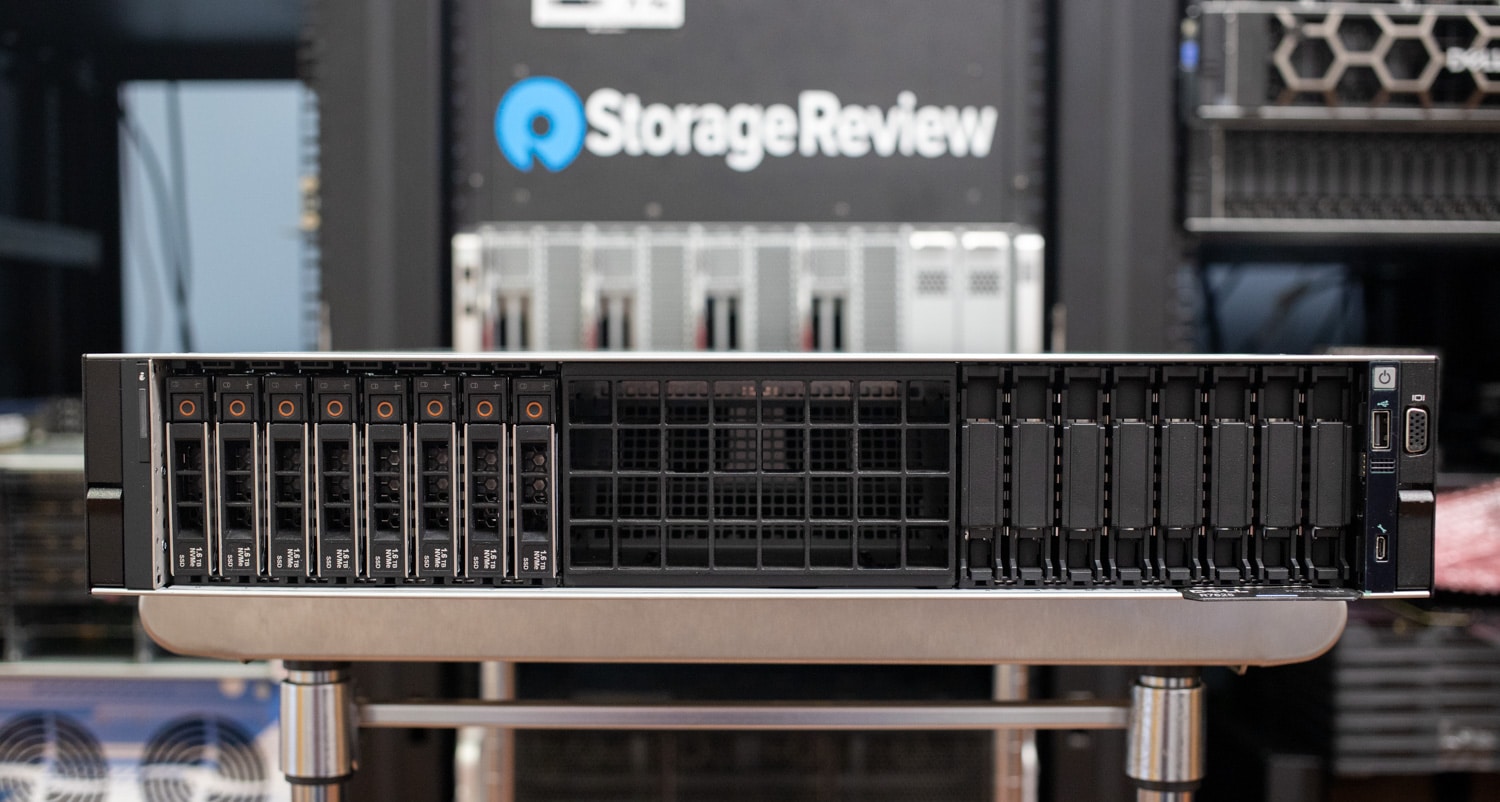
Dell PowerEdge R7625 Specifications
The PowerEdge R7625 is essentially a dual-socket (CPU) version of the PowerEdge R7615, offering greater computational power and double the memory ceiling (6TB). It replaces the PowerEdge R7525 in Dell’s high-end AMD rack server line.
This 2U server is based on AMD’s “Genoa” fourth-generation EPYC processors (and supports up to an amazing 128 cores/256 threads per socket. The platform brings all the latest technologies in tow, including 12-channel DDR5-4800 memory (24 DIMMs, 12 per socket) and PCIe Gen 5.
Advantages of this fourth-generation AMD platform over the outgoing second- and third-generation EPYC include faster CPU interconnects (32GT/s versus 16GT/s) and DDR5 and PCIe Gen5 support. Unlike its predecessor, the PowerEdge R7625 also offers direct liquid cooling. Dell also appears to be offering more software and security features, including OpenManage integrations and enhanced embedded management.
This server can be configured for almost any task. It fits 24x 2.5-inch, 12x 3.5-inch, or 32 E3.S Gen5 drives in its front bays, though it can also be configured for GPU compute, fitting two double-wide 300-watt cards or six single 75-watt accelerator cards; the NVIDIA L4 GPU is an ideal example of the latter. Expansion slots include up to eight PCIe (four Gen5 or eight Gen4).
| Processor | Two AMD EPYC 4th Generation 9004 series processors |
| Memory | 32x DDR5-4800 RDIMM, 6TB max. |
| Storage Controllers |
|
| Drive Bays | Front bays:
Rear bay:
|
| Power Supplies | Hot-swap PSUs with full redundancy, up to 3200W Titanium 277 VAC or 336 VDC |
| Cooling Options |
|
| Fans | Up to six High performance Silver / High Performance Gold hot plug fans |
| Form Factor | 2U rack server |
| Embedded Management |
|
| OpenManage Software |
|
| Mobility | OpenManage Mobile |
| OpenManage Integrations |
|
| Security |
|
| Embedded NIC | 2 x 1GbE LOM card (optional) |
| Networking Options | 1x OCP card 3.0 (optional) |
| GPU Options | Up to two double wide 300W, or six single wide 75W accelerators |
| Front Ports |
|
| Rear Ports |
|
| PCIe | Up to eight PCIe slots:
|
| Operating System and Hypervisors |
|
Dell PowerEdge R7625 iDRAC9 Remote Management
We looked at Dell’s iDRAC9 management solution in our PowerEdge R7615 review, but we’ll do a brief tour here as well. Our server came equipped with the Enterprise version.
The main dashboard shows overall server health and system information, plus recent log information.
The storage section shows available drives and controllers and their health.
System settings are easily navigable by category.
We continue to think highly of iDRAC9 for its intuitive interface, reliable controls, and effective server administration tools.
Dell PowerEdge R7625 Build and Design
The PowerEdge R7625 has a standard 2U rack server appearance and dimensions. Our unit has eight 2.5-inch bays. A 24 2.5-inch bay backplane is available, but not having the eight center drives improves airflow. Front ports include micro-USB for dedicated iDRAC support, one USB 2.0, and one VGA video-out.
The view below is with the security bezel installed.
Rear ports include one USB 2.0, one iDRAC Ethernet port, and one USB 3.0, VGA video-out. Not in our configuration, but the PowerEdge R7625 can fit two or four 2.5-inch drives or four EDSFF E3.S drives. The redundant power supplies are positioned at either end; the top option is 3,200 watts Titanium.
Our server has the BOSS drive option, which can be configured with the embedded RAID controller for redundant boot.
Removing the top service panel reveals the rather clean interior of our review unit, which doesn’t have any expansion cards installed and has only a few DIMM slots filled. We removed the risers for this photo.
Here’s the server with the risers in place; also notice the airflow guides over the CPU heatsinks. Nearly everything is serviceable without tools, something we always appreciate.
The PowerEdge R7625 is available with direct liquid cooling, but the 32-core EPYC CPUs in our unit are perfectly fine with air cooling. Note the PowerEdge R7625’s maximum complement of six centerline fans, which are easily swapped by grabbing the orange tabs. The 24 DIMM slots (12 per CPU) support 6TB of DDR5-4800 RAM.
Removing the fans shows the 16-way storage backplane. Dell offers many other storage backplanes.
Dell PowerEdge R7625 Performance
Our review server has the following specifications:
- Dual AMD EPYC 9354 CPUs (each 32 cores/64 threads, 280-watt TDP, 3.25GHz base, 3.75GHz boost, 256MB L3)
- 32GB RAM (1 DIMM per CPU)
This basic configuration will provide just a taste of this platform; top models scale to a 128-core EPYC 9754 with liquid cooling and 6TB of RAM, so it can be powerful enough for virtually any task. Note our unit’s mere 32GB of RAM did prevent it from running some of our benchmarks. We are not listing storage drives as we won’t be testing storage performance in this platform.
Our comparison system is the Dell PowerEdge 7615 with a single EPYC 9354 CPU, so we expect to see almost linear performance scaling considering our PowerEdge R7625 has two of those same CPUs. The PowerEdge 7615 has the advantage of two DIMMs per socket, so it should offer greater memory bandwidth and may have an edge in some benchmarks that don’t take advantage of multiple CPUs.
Blender OptiX
Blender is an open-source 3D modeling application. This benchmark was run using the Blender Benchmark utility. The score is samples per minute, with higher being better. We ran versions 3.6 and 4.0.
The PowerEdge R7625 nearly doubled the scores of the R7615 as expected, given it has twice the processing power.
| Blender OptiX Version 3.6 (CPU) (Samples per minute; Higher is better) | Dell PowerEdge R7625 (2x AMD EPYC 9354) | Dell PowerEdge R7615 (AMD EPYC 9354) |
| Monster | 765 | 397 |
| Junkshop | 459 | 245 |
| Classroom | 392 | 200 |
| Blender OptiX Version 4.0 (CPU) (Samples per minute; Higher is better) | Dell PowerEdge R7625 (2x AMD EPYC 9354) | Dell PowerEdge R7615 (AMD EPYC 9354) |
| Monster | 726 | 375 |
| Junkshop | 474 | 248 |
| Classroom | 389 | 198 |
Blackmagic RAW Speed Test
We have also started running Blackmagic’s RAW speed test, which tests video playback. This is more of a hybrid test that includes CPU and GPU performance for real-world RAW decoding. The PowerEdge R7615 has the edge here; it’s likely this test only uses one CPU, and the R7615 has two DIMMs per channel where our PowerEdge R7625 only has one.
| Blackmagic RAW Speed Test (Higher is better) | Dell PowerEdge R7625 (2x AMD EPYC 9354) | Dell PowerEdge R7615 (AMD EPYC 9354) |
| 8K CPU | 53 fps | 59 fps |
| 8K CUDA | N/A | N/A |
UL Procyon AI Inference
UL’s Procyon estimates a workstation’s performance for professional apps. This is another instance where the PowerEdge R7615’s higher memory bandwidth (again, only due to the configurations of our review units, not a hardware limitation) helped it gain the edge, as this test also doesn’t utilize multiple CPUs.
| UL Procyon Average Inference Times (Lower is better) | Dell PowerEdge R7625 (2x AMD EPYC 9354) | Dell PowerEdge R7615 (AMD EPYC 9354) |
| MobileNet V3 | 5.54 | 4.27 |
| ResNet 50 | 20.61 | 18.39 |
| Inception V4 | 80.08 | 70.70 |
| DeepLab V3 | 65.35 | 59.17 |
| YOLO V3 | 92.37 | 84.89 |
| Real-ESRGAN | 5,691.98 | 5,233.51 |
| Overall Score | 60 | 68 |
y-cruncher
y-cruncher is a multi-threaded and scalable program that can compute Pi and other mathematical constants to trillions of digits. Since its launch in 2009, it has become a popular benchmarking and stress-testing application for overclockers and hardware enthusiasts. The PowerEdge R7625’s dual EPYC CPUs gave it a sizable performance advantage over the single-CPU R7615, though the scaling wasn’t linear, again perhaps due to the different memory configurations.
| y-cruncher (Total Computation time) | Dell PowerEdge R7625 (2x AMD EPYC 9354) | Dell PowerEdge R7615 (AMD EPYC 9354) |
| 1 billion digits | 22.868 | 36.686 |
| 2.5 billion digits | 56.678 | 98.68 |
| 5 billion digits | 118.455 | N/A |
Geekbench 6
Geekbench 6 is a cross-platform benchmark that measures overall system performance. You can find comparisons to any system you want in the Geekbench Browser. This test likely doesn’t take full advantage of dual CPUs and/or as many cores are in our PowerEdge R7625 either, as its multi-core score is only 12% higher than the R7615’s.
| Geekbench 6 (Higher is better) | Dell PowerEdge R7625 (2x AMD EPYC 9354) | Dell PowerEdge R7615 (AMD EPYC 9354) |
| CPU Single-Core | 2,074 | 2,070 |
| CPU Multi-Core | 13,487 | 12,049 |
| GPU | N/A | N/A |
Cinebench R23
This benchmark uses all CPU cores and threads to generate an overall score. These PowerEdge servers showed predictably close single-core scores. The multi-core was well in favor of the PowerEdge R7625, though the scaling was again not linear.
| Cinebench R23 (Higher is better) | Dell PowerEdge R7625 (2x AMD EPYC 9354) | Dell PowerEdge R7615 (AMD EPYC 9354) |
| Multi-Core | 88,551 | 52,401 |
| Single-Core | 1,338 | 1,343 |
| MP Ratio | 66.20x | 39.03x |
Cinebench 2024
We also started running the latest Cinebench test. The performance scaling was even less linear here; perhaps this benchmark relies more on memory performance than Cinebench R23.
| Cinebench R23 (Higher is better) | Dell PowerEdge R7625 (2x AMD EPYC 9354) | Dell PowerEdge R7615 (AMD EPYC 9354) |
| Multi-Core | 2,974 | 2,014 |
| Single-Core | 76 | 71 |
| MP Ratio | 38.95x | 28.29x |
Verdict
The Dell PowerEdge R7625 takes the potential of the R7615 much further by incorporating a second CPU socket and doubling the memory ceiling to 6TB. This 2U server is exceptionally versatile, thanks to Dell’s seemingly endless configuration options; it can be everything from a storage box to VDI and HPC. It can also serve AI, deep learning, and inferencing needs well because of its eight PCIe slots, which can fit two double-wide or six single-wide accelerator cards.
AMD’s fourth-generation EPYC processors are also highly impressive, with support for a whopping 128 cores per socket. Dell’s available direct liquid cooling is a big plus for running heavy workloads over extended periods. Granted, our modest review configuration (two 32-core EPYC 9354 CPUs) didn’t allow us to explore the full potential of this platform, but what we saw was well within expectations.
We also give Dell credit for the PowerEdge R7625’s ease of serviceability, with many hot-swappable and toolless components, and its excellent iDRAC9 remote management console. Overall, the PowerEdge R7625’s versatility, performance, and software support earn it our recommendation.
Engage with StorageReview
Newsletter | YouTube | Podcast iTunes/Spotify | Instagram | Twitter | TikTok | RSS Feed

